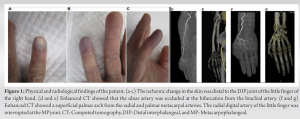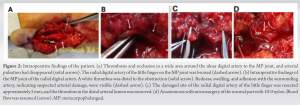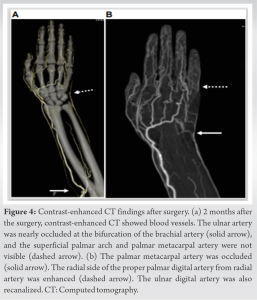When a patient presents with hypothenar hammer syndrome-like symptoms and is unresponsive to conservative treatment, we should use contrast-enhanced computed tomography for evaluating the entire upper extremity and consider surgical treatment.
Dr. Gaku Niitsuma, Department of Orthopaedic Surgery, Showa University School of Medicine, 1-5-8, Hatanodai, Shinagawa-Ku, Tokyo 142-8666, Japan. E-mail: gaku-nii09@med.showa-u.ac.jp
Introduction: We present a rare case of ischemia caused by blunt trauma at the metacarpophalangeal joint, with no fracture or dislocation. This case resulted in digital arterial injury of the little finger with a pathological mechanism similar to that of hypothenar hammer syndrome (HHS).
Case Report: Pre-operative computed tomography (CT) revealed an occluded ulnar artery at the brachial artery bifurcation and occluded ulnar digital artery in the little finger. The blunt trauma to the radial digital artery of the little finger caused ischemia. Arterial anastomosis was performed microsurgically to preserve the little finger. Necrosis was successfully prevented. The condition of the finger improved gradually, with no restriction in the range of motion
Conclusion: When a patient presents with HHS-like symptoms and is unresponsive to conservative treatment, surgical treatment should be considered. We recommend using contrast-enhanced CT for evaluating the entire upper extremity, even for ischemia associated with blunt hand trauma, such as HHS
Keywords: Hypothenar hammer syndrome, metacarpophalangeal joint, ulnar artery, hand, ischemia, anastomosis
Hypothenar hammer syndrome (HHS) is caused by blunt trauma to the hypothenar due to a single strong or repeated external insult. We report a rare case of ischemia caused by blunt trauma at the metacarpophalangeal (MP) joint, without fracture or dislocation. This case resulted in digital arterial injury of the little finger, with a pathological mechanism similar to that of HHS. The little finger was rescued by performing arterial anastomosis.
A 70-year-old man complained of color change on the right side of his little finger, which was injured while hitting a metal can repeatedly with a wrench for the 1st time, and presented to our hospital on the same day. His condition was diagnosed as atrial fibrillation and hypertension 14 years ago, for which he took the anticoagulant warfarin (3 mg/day) along with a β-blocker (2.5 mg/day) and an angiotensin-converting enzyme (ACE) inhibitor (2.5 mg/day) for 14 years. The patient had no history of smoking. The injury was on his right hand (the dominant side). The ischemic change in the skin was distal to the distal interphalangeal (DIP) joint of the little finger (Fig. 1a-c). He reported sensory disturbance and pain in the same region, and a feeling of coldness distal to the MP joint. The digital Allen test was negative. The range of motion (ROM) was normal. The manual muscle testing (MMT) of the flexor digitorum profundus (FDP) and flexor digitorum superficialis (FDS) yielded a 5/5 score. The Semmes-Weinstein monofilament test (S-W test) score was 4.56 (normal: 1.65–2.83, diminished light touch: 3.22–3.61, diminished protective sensation: 3.84–4.31, loss of protective sensation: 4.56–6.65, and untestable: ≥6.65). X-ray findings were normal. Computed tomography (CT) images showed no fracture. Contrast-enhanced CT showed a superficial palmar arch from the radial and palmar metacarpal arteries. The ulnar artery was occluded at the bifurcation from the brachial artery (Fig. 1d and e).
The radial digital artery of the little finger was interrupted at the proximal metacarpal bone (Fig. 1f and g). The superficial palmar arch, common palmar digital artery, and ulnar digital artery of the little finger were also not enhanced. Intravenous prostaglandin E1 (PGE1) administration slightly improved the skin color, and the disorder was considered to be reversible vasospasm, with no neuropraxia. We prescribed PGE1 tablets and instructed the patient to continue taking warfarin, β-blocker, and ACE inhibitor as before. He was also instructed to keep his finger warm using protective gloves and recommended to rest at home during the observation period. In addition, we prescribed acetaminophen for inflammation and pain relief. After 1 week, his symptoms did not improve. The patient presented with signs of ischemia restricted to the tip of his little finger, which did not correspond to the CT findings. As the signs of ischemia were restricted to the distal end, surgical intervention was necessary to confirm the viability of the blood vessels. Urgent adventitial dissection of the artery was performed. An axillary nerve block was performed under echo guidance. However, blood flow did not improve due to the vasodilatory effect of the block. Blood flow did not resume sufficiently despite adventitial dissection of both sides of the digital arteries at the DIP joint. Therefore, arterial occlusion was suspected to be caused by thrombus formation and not by spasm. Furthermore, extending the adventitial dissection to the proximal revealed extensively occluded ulnar digital artery (Fig. 2a). Dissecting the MP joint revealed a bruise around the radial digital artery, which was adhering to the surrounding tissue. Proximal to the site, the artery had good pulsation (Fig. 2b). However, blood flow did not recanalize with the adventitial dissection of the digital artery. Thrombi, occlusion, and a corkscrew appearance were observed in the area extending from the DIP joint to the MP joint on the ulnar side, which was different from the radial side (Fig. 2a).
Radial digital artery reconstruction was scheduled. We made a partial incision in the wall of the occluded artery. The thrombus in the arterial lumen was removed, and the incised arterial wall was subsequently sutured. However, blood flow did not recanalize. It was completely occluded in this region. Approximately 5 mm of the injured artery was resected, and a thrombus found distal to the arterial lumen was removed (Fig. 2c). The normal artery was anastomosed. The digital artery recanalized thereafter (Fig. 2d). The pain subsided immediately after surgery. A continuous infusion of heparin (8,000 units/day) and PGE1 was administered for 1 week. Cefazolin (2 g/day) was infused for 3 days after surgery. The color tone improved and stabilized (Fig. 3a). Final ROM (flexion/extension) values were MP 85/5, PIP 80/-5, and DIP 70/-5 (Fig. 3b).
The S-W test score also normalized (1.65), and MMT results of the FDP and FDS were stable (5/5). The digital artery was examined using a color Doppler system (SONIMAGE MX1, Konica Minolta Inc., Tokyo, Japan; L11-3 MHz Linear probe, total scan depth of 20 mm). Echography revealed stable blood flow in the anastomosed artery on the radial side (Fig. 3c). The blood flow was lower in the ulnar digital artery of the MP joint than in the radial side on the sagittal view (Fig. 3d). The ulnar-side artery had a smaller diameter and less blood flow than the radial side on the coronal section at the DIP joint (Fig. 3e). Contrast-enhanced CT re-evaluation of the artery 1 month after the surgery revealed persistent ulnar artery occlusion at the bifurcation of the brachial artery (Fig. 4a, solid arrow). The proper palmar digital artery of ulnar side was occluded (Fig. 4a, dashed arrow). Therefore, the occlusion was thought to have existed before this trauma. The radial side from radial artery was enhanced (Fig. 4b, dashed arrow), and anastomosis was effective. The patient’s recovery was unremarkable, with no associated symptoms observed at the final follow-up visit one year after surgery.
Levels of expertise of the surgeons
The levels of expertise of the surgeons involved with this article, according to Tang and Giddins [1], were as follows: Author 1 (Level 4-Specialist, highly experienced); author 2 (Level 5-Expert); and author 3 (Level 5-Expert).
We described a rare case of ischemia caused by blunt trauma at the MP joint without fracture or dislocation, which resulted in digital arterial injury of the little finger. The previous reports have described HHS caused by such blunt trauma [2]. However, we did not observe finger ischemia due to digital arterial injury associated with blunt trauma at the MP joint. Causes of arterial occlusion, including HHS, can be trauma, embolism and thrombus, arterial malformation, thoracic outlet syndrome and quadrilateral space syndrome (i.e., constriction), medium and small-vessel vasculitis, Raynaud’s disease, antiphospholipid antibody syndrome, myeloproliferative disorders, sclerosis, hypercoagulable states, and immune-mediated/inflammatory disease [3, 4]. Miyayama et al. reported two patients with heart disease and thrombosis of the upper extremity, which accounted for 19% of the total thrombosis [5]. Of the thromboembolisms in the upper arm, Haimovici reported that ulnar artery occlusion occurred in 1.6% of all cases, and it often developed anatomically on the right side [6]. Thromboembolism of the ulnar artery occurred in 0.3% of all cases. Our patient had a history of atrial fibrillation and was consuming warfarin, indicating a possibility of thromboembolism. We believe that the subacute ulnar artery occlusion was caused by thrombus formation based on the patient’s medical history. If the ulnar artery occlusion was chronic, the collateral vessels would have been more developed. As a consequence, the radial digital artery of the little finger was occluded by blunt trauma in that state. The treatment for hand ischemia, including HHS, remains unclear. St-Pierre et al. summarized possible treatments of hand ischemia from the previous reports [3]. The first choice of treatment was thrombolytics and anti-platelet drugs within 2 weeks. If symptoms persisted, a catheter was used to clear any blockage. If symptoms persisted or worsened, surgical revascularization was performed. In addition, if the symptoms progressed rapidly, surgical revascularization was required. Thus, the treatment choice was appropriate in this case. Regarding the indications for and long-term results of surgery, Kitzinger et al. stated that the indications for surgery are severe symptoms and resistance to conservative treatment [7]. They also reported the effectiveness of surgical revascularization and improvement in 9(75%) of 12 cases. As a caveat, Iannuzzi et al. reported that if the cause of thrombus is investigated but left untreated, it can recur even after surgical treatment [4]. However, regarding conservative treatment, Adams et al. reported that the recurrence of symptoms and cold intolerance often persisted [8]. In our case, the patient had a surgical indication, because symptoms persisted despite the conser vative treatment and axillary nerve block. Intraoperative corkscrew appearance and extensive thrombotic occlusion of the ulnar digital artery were diagnosed as changes associated with previous ulnar artery occlusion. Gardiner and Tan reported that ischemia associated with blunt hand trauma is influenced by the history of the artery, the fragility of the arterial walls, and a narrowed arterial lumen that leads to the formation of blood clots [9]. In addition, a corkscrew appearance is a characteristic finding associated with arterial wall weakening. We considered the possibility of peripheral artery changes associated with ulnar artery occlusion or arterial wall weakening due to the underlying condition. Luczak et al. reported ischemia of the finger due to closed trauma of the MP joint with dislocation of a closed proximal phalanx fracture [10]. However, we could not find any reports of finger ischemia caused solely by blunt trauma of the MP joint without fracture or dislocation. This observation might be explained by the fact that blunt trauma cannot simultaneously damage both digital arteries, and trauma of one digital artery cannot lead to ischemia with the transverse blood flow.
Herein, we reported a rare case of ischemia caused by blunt trauma to the MP joint that resulted in digital artery injury of the little finger. This trauma had a pathological mechanism similar to that of HHS. The ulnar artery occluded subacutely. In addition to that state, a blunt trauma caused damage and occlusion of the radial digital artery of the little finger, which resulted in ischemia as it occurred. We believe that contrast-enhanced CT is an ideal tool for the evaluation of the entire upper extremity, even for ischemia associated with hand trauma, such as HHS. However, it is necessary to carefully investigate cases with inconsistencies between CT findings and clinical findings.
This report showed that it is important to assess blood flow of the whole upper limbs with enhanced CT even if HHS is suspected.
References
- 1.Tang JB, Giddins G. Why and how to report surgeons’ levels of expertise. J Hand Surg Eur Vol 2016;41:365-6. [Google Scholar]
- 2.Scharnbacher J, Claus M, Reichert J, Röhrl T, Hoffmann U, Ulm K, et al. Hypothenar hammer syndrome: A multicenter case-control study. Am J Ind Med 2013;56:1352-8. [Google Scholar]
- 3.St-Pierre F, Shepherd RF, Bartlett MA. Diagnosis of hypothenar hammer syndrome in a patient with acute ulnar artery occlusion. BMJ Case Rep 2019;12:e230963. [Google Scholar]
- 4.Iannuzzi NP, Higgins JP. Acute arterial thrombosis of the hand. J Hand Surg Am 2015;40:2099-106. [Google Scholar]
- 5.Miyayama S, Yamashiro M, Shibata Y, Hashimoto M, Yo s h i da M, Tsu j i K , e t a l . Th romb ol y sis and thromboaspiration for acute thromboembolic occlusion in the upper extremity. Jpn J Radiol 2012;30:180-4. [Google Scholar]
- 6.Haimovici H. Cardiogenic embolism of the upper extremity. J Cardiovasc Surg (Torino) 1982;23:209-13. [Google Scholar]
- 7.Kitzinger HB, van Schoonhoven JV, Schmitt R, Hacker S, Karle B. Hypothenar hammer syndrome: Long-term results after vascular reconstruction. Ann Plast Surg 2016;76:40-5. [Google Scholar]
- 8.Adams NS, Ford RD. Recurrent hypothenar hammer syndrome: A case report. J Hand Surg Asian Pac Vol 2016;21:414-6. [Google Scholar]
- 9.Gardiner GA Jr., Tan A. Repetitive blunt trauma and arterial injury in the hand. Cardiovasc Intervent Radiol 2017;40:1659-68. [Google Scholar]
- 10.Luczak BP, Maher R, Gurfinkel R, Teh LG. Closed digital artery injury. Ochsner J 2011;11:139-42. [Google Scholar]












